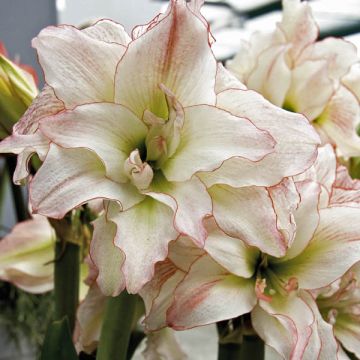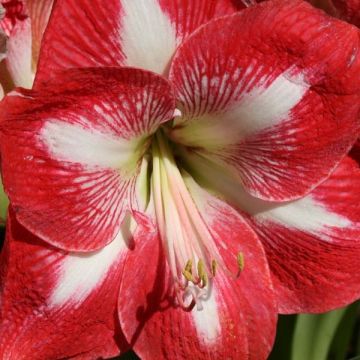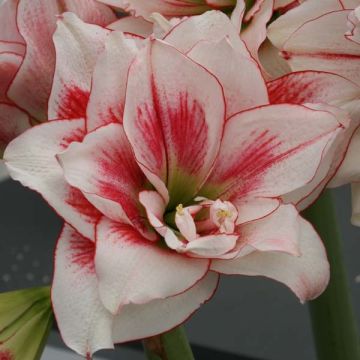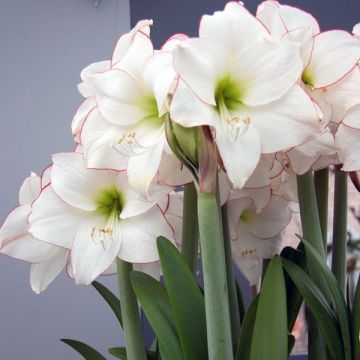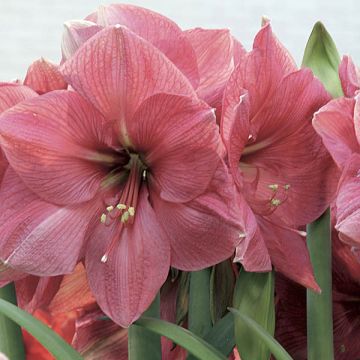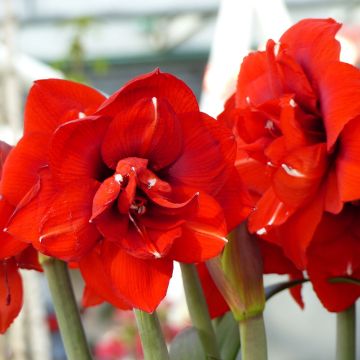

Hippeastrum Sleeping Beauty
Hippeastrum Sleeping Beauty
Hippeastrum Sleeping Beauty®
Amaryllis
Why not try an alternative variety in stock?
View all →This plant carries a 6 months recovery warranty
More information
We guarantee the quality of our plants for a full growing cycle, and will replace at our expense any plant that fails to recover under normal climatic and planting conditions.
From €5.90 for pickup delivery and €6.90 for home delivery
Express home delivery from €8.90.
Does this plant fit my garden?
Set up your Plantfit profile →
Description
Amaryllis 'Sleeping Beauty' is a brand new variety of hippeastrum that prioritises the number of flowers over their size, while offering a contrasting colour scheme in red and white. In this Hippeastrum, one bulb will produce up to 4 flowering stems, each carrying up to 4 trumpet-shaped flowers, each measuring less than 12 cm (5in) in diameter. Stunning in a pot, where it will bloom around Christmas, this plant can also be planted in the ground in protected gardens along the Mediterranean coast.
Originally from subtropical regions of Central and South America, Hippeastrum are frost-sensitive plants belonging to the Amaryllidaceae family, generally grown in pots in our latitudes. The Sleeping Beauty variety, registered in 2019, belongs to the group of hummingbird Amaryllis, which are characterised by small flowers. In full bloom, the plant forms a clump 40 to 50 cm (16 to 20in) tall and 30 cm (12in) wide. It offers very round, thick and fleshy, iridescent flowers. The flower is composed of overlapping rounded petals, bright red in colour, adorned with a white spot in the centre. The heart of the flower is yellow and lime green, with a bouquet of long curved stamens. 2 or 3 thick and hollow flowering stems emerge from the bulb, almost simultaneously. The leaves are ribbon-like, medium green, slightly shiny. They turn yellow and then dry out a few weeks after flowering.
Planting an Amaryllis is very rewarding. Hippeastrum is very easy to grow and its growth is extremely rapid; 6 to 10 weeks after planting, the flowers bloom. You can enjoy them throughout the winter. To give it as a Christmas gift, consider planting it at the beginning of November. The Sleeping Beauty variety does not need companions to showcase its obvious beauty. You can plant a few simple snowdrop bulbs at its base, just to dress up its slightly rigid flowering stems. Preferably expose it to sun, in a window for example. Trim the stem when the flowers fade to promote re-flowering.
Amaryllis is actually a misnomer directly related to an error made in the 18th century. It was Linnaeus himself who used it to name the American species. However, the name was already used for another South African plant. The name Amaryllis has been retained for both and to distinguish them, Hippeastrum is added to the first one and Belladona to the second. It must be admitted that both deserve this name: Amaryllis means 'sparkling' and, in classical Greek literature, the plant has been the subject of a pastoral poem where the beautiful shepherdess Amaryllis dies of a love that will only be accessible to her after a terrible wound.
Report an error about the product description
Hippeastrum Sleeping Beauty in pictures


Plant habit
Flowering
Foliage
Botanical data
Hippeastrum
Sleeping Beauty®
Amaryllidaceae
Amaryllis
Cultivar or hybrid
Other Hippeastrum - Amaryllis
Planting and care
You can plant the Sleeping Beauty Amaryllis bulbs from October to the end of April. Choose a pot that is not too big,1-2cm (1in) larger than the size of the bulb. Place a layer of drainage at the bottom. Mix half potting compost, half garden soil. Only bury the bulb halfway. Place the pot in a warm and bright location. Water sparingly until the stem appears. Then water daily. 6 to 8 weeks later, your bulbs will flower. Our advice: if you choose multiple bulbs, plant them with a two-week interval to enjoy the beauty of Amaryllis all winter. How to make my Amaryllis flower again? After flowering, remove the faded flowers and let the leaves develop. Continue to water regularly and give them indoor plant fertiliser every 15 days. This is when the bulb replenishes itself to prepare for next year's flowers. After 4 to 6 months, forget about your potted plants, let them rest for about 3 months in a sheltered place. You can then remove the faded leaves, repot in fresh soil, and start a new growing cycle.
Planting period
Intended location
Care
This item has not been reviewed yet - be the first to leave a review about it.
Haven't found what you were looking for?
Hardiness is the lowest winter temperature a plant can endure without suffering serious damage or even dying. However, hardiness is affected by location (a sheltered area, such as a patio), protection (winter cover) and soil type (hardiness is improved by well-drained soil).

Photo Sharing Terms & Conditions
In order to encourage gardeners to interact and share their experiences, Promesse de fleurs offers various media enabling content to be uploaded onto its Site - in particular via the ‘Photo sharing’ module.
The User agrees to refrain from:
- Posting any content that is illegal, prejudicial, insulting, racist, inciteful to hatred, revisionist, contrary to public decency, that infringes on privacy or on the privacy rights of third parties, in particular the publicity rights of persons and goods, intellectual property rights, or the right to privacy.
- Submitting content on behalf of a third party;
- Impersonate the identity of a third party and/or publish any personal information about a third party;
In general, the User undertakes to refrain from any unethical behaviour.
All Content (in particular text, comments, files, images, photos, videos, creative works, etc.), which may be subject to property or intellectual property rights, image or other private rights, shall remain the property of the User, subject to the limited rights granted by the terms of the licence granted by Promesse de fleurs as stated below. Users are at liberty to publish or not to publish such Content on the Site, notably via the ‘Photo Sharing’ facility, and accept that this Content shall be made public and freely accessible, notably on the Internet.
Users further acknowledge, undertake to have ,and guarantee that they hold all necessary rights and permissions to publish such material on the Site, in particular with regard to the legislation in force pertaining to any privacy, property, intellectual property, image, or contractual rights, or rights of any other nature. By publishing such Content on the Site, Users acknowledge accepting full liability as publishers of the Content within the meaning of the law, and grant Promesse de fleurs, free of charge, an inclusive, worldwide licence for the said Content for the entire duration of its publication, including all reproduction, representation, up/downloading, displaying, performing, transmission, and storage rights.
Users also grant permission for their name to be linked to the Content and accept that this link may not always be made available.
By engaging in posting material, Users consent to their Content becoming automatically accessible on the Internet, in particular on other sites and/or blogs and/or web pages of the Promesse de fleurs site, including in particular social pages and the Promesse de fleurs catalogue.
Users may secure the removal of entrusted content free of charge by issuing a simple request via our contact form.
The flowering period indicated on our website applies to countries and regions located in USDA zone 8 (France, the United Kingdom, Ireland, the Netherlands, etc.)
It will vary according to where you live:
- In zones 9 to 10 (Italy, Spain, Greece, etc.), flowering will occur about 2 to 4 weeks earlier.
- In zones 6 to 7 (Germany, Poland, Slovenia, and lower mountainous regions), flowering will be delayed by 2 to 3 weeks.
- In zone 5 (Central Europe, Scandinavia), blooming will be delayed by 3 to 5 weeks.
In temperate climates, pruning of spring-flowering shrubs (forsythia, spireas, etc.) should be done just after flowering.
Pruning of summer-flowering shrubs (Indian Lilac, Perovskia, etc.) can be done in winter or spring.
In cold regions as well as with frost-sensitive plants, avoid pruning too early when severe frosts may still occur.
The planting period indicated on our website applies to countries and regions located in USDA zone 8 (France, United Kingdom, Ireland, Netherlands).
It will vary according to where you live:
- In Mediterranean zones (Marseille, Madrid, Milan, etc.), autumn and winter are the best planting periods.
- In continental zones (Strasbourg, Munich, Vienna, etc.), delay planting by 2 to 3 weeks in spring and bring it forward by 2 to 4 weeks in autumn.
- In mountainous regions (the Alps, Pyrenees, Carpathians, etc.), it is best to plant in late spring (May-June) or late summer (August-September).
The harvesting period indicated on our website applies to countries and regions in USDA zone 8 (France, England, Ireland, the Netherlands).
In colder areas (Scandinavia, Poland, Austria...) fruit and vegetable harvests are likely to be delayed by 3-4 weeks.
In warmer areas (Italy, Spain, Greece, etc.), harvesting will probably take place earlier, depending on weather conditions.
The sowing periods indicated on our website apply to countries and regions within USDA Zone 8 (France, UK, Ireland, Netherlands).
In colder areas (Scandinavia, Poland, Austria...), delay any outdoor sowing by 3-4 weeks, or sow under glass.
In warmer climes (Italy, Spain, Greece, etc.), bring outdoor sowing forward by a few weeks.

































